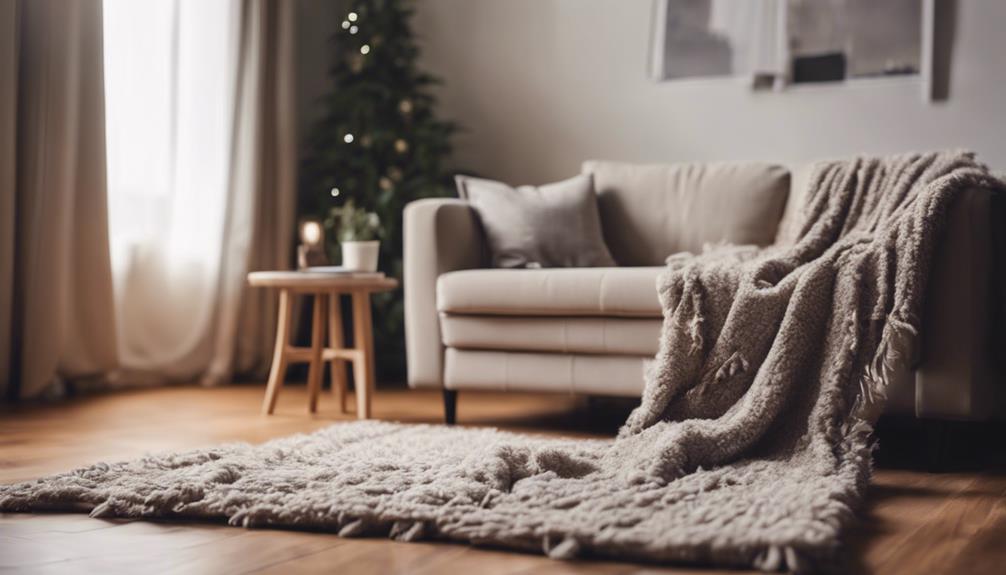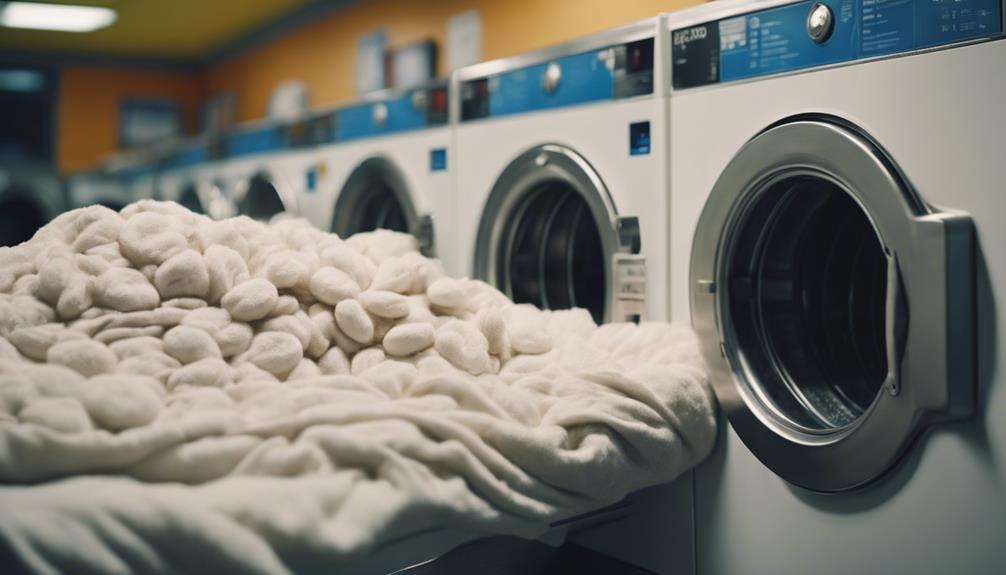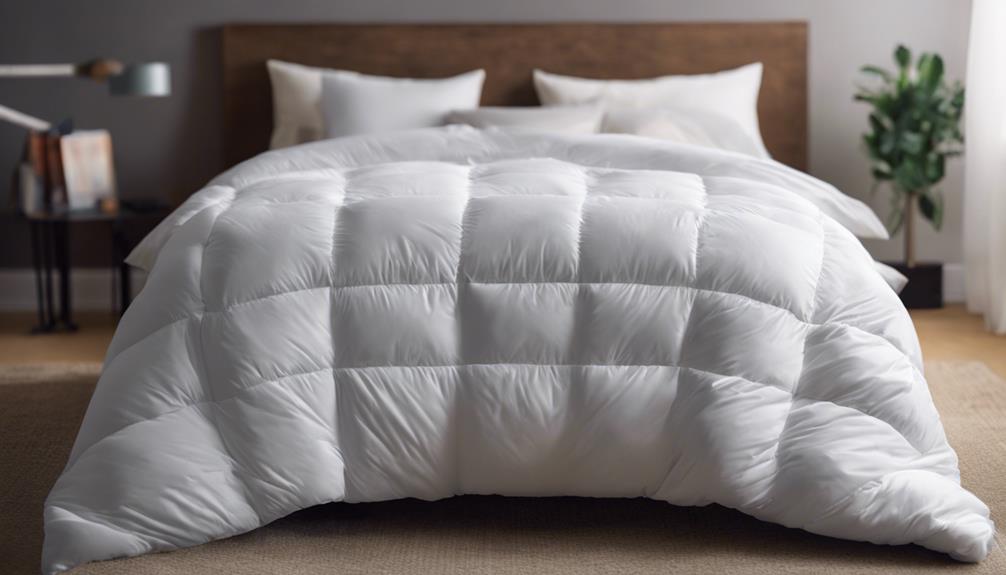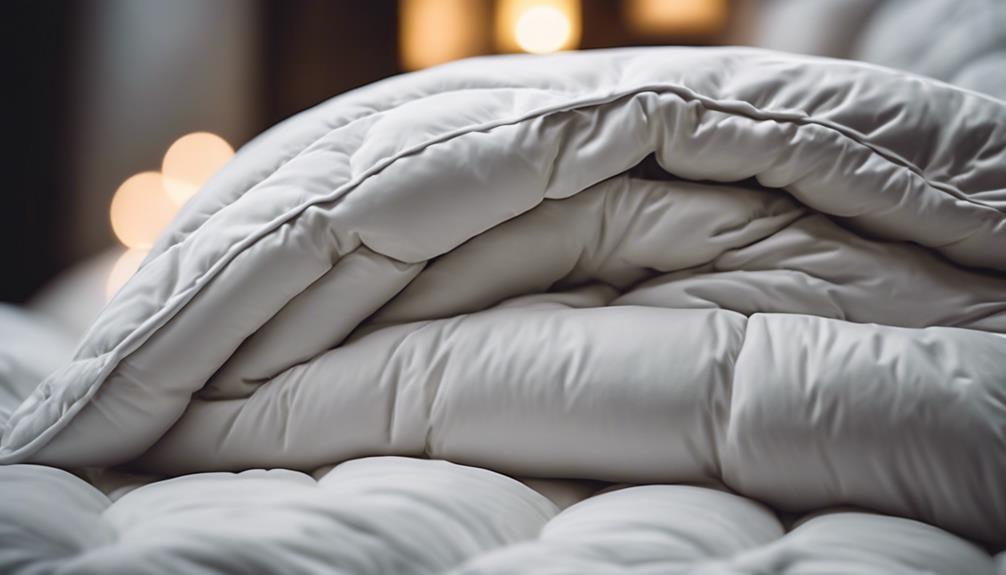When you need to have your comforter cleaned, we suggest considering Tide Cleaners or your local dry cleaners. Tide Cleaners offers professional and fabric-safe cleaning services, ensuring that your comforter’s quality and lifespan are maintained. Local dry cleaners specialize in comforter cleaning, with prices usually around $24.99. They are skilled in handling various fabrics and stains efficiently, which saves you time and helps uphold high cleanliness standards. Whether you choose Tide Cleaners or local services, rest assured that your comforter will be expertly cared for to ensure it stays fresh and clean. For more information on top-rated comforter cleaning providers and convenient options, please explore further.
Key Takeaways
- Tide Cleaners offers professional dry cleaning services for comforters.
- Local dry cleaners provide specialized comforter cleaning at around £24.99.
- The Cinnamon Club, Ma La, Bbar, and Laughing Halibut are top-rated comforter cleaning providers.
- Convenient drop-off or delivery options available for comforter cleaning.
- Trust Tide Cleaners for expert fabric care and thorough cleaning to extend comforter lifespan.
Tide Cleaners: Professional Comforter Cleaning Services

Choosing Tide Cleaners for professional comforter cleaning guarantees a thorough and fabric-safe cleaning process, prolonging the lifespan of your bedding. When it comes to comforter cleaning, especially for those that aren't machine washable, dry cleaning services at Tide Cleaners are the ideal solution. Our team of experts ensures that each comforter receives the proper care it needs to maintain its quality. By following specific fabric care instructions for every comforter, we can guarantee a deep cleaning that removes dirt and stains effectively.
At Tide Cleaners, we grasp the importance of keeping your bedding fresh and clean. Our professional approach to comforter cleaning goes beyond just removing visible dirt; we focus on preserving the fabric and extending the life of your comforter. With our dry cleaning services, you can trust that your comforter will be in good hands. Visit Tide Cleaners locations for expert care and exceptional results in comforter cleaning.
Local Dry Cleaners Offering Comforter Cleaning

After exploring Tide Cleaners' professional comforter cleaning services, let's now shift our focus to local dry cleaners in London that offer specialized cleaning for comforters.
When looking for convenient options for cleaning your comforter, local dry cleaners can be a reliable choice. These establishments in London provide professional dry cleaning services that guarantee a thorough and fabric-safe cleaning process for your delicate comforters. Typically priced around £24.99, these dry cleaners use specialized techniques to safeguard the quality and lifespan of your bedding items.
Opting for local dry cleaners for comforter cleaning can save you time and effort while ensuring a high standard of cleanliness. The expertise of these professionals in handling different types of fabrics and stains makes them well-equipped to tackle the cleaning of your comforters effectively. By choosing a local dry cleaner that offers comforter cleaning services, you can maintain the cleanliness and longevity of your bedding items with ease.
Best Laundry Services for Comforter Cleaning

When selecting a laundry service for comforter cleaning, consider the convenience and expertise provided by Tide Cleaners. Here are three reasons why Tide Cleaners stands out for comforter cleaning:
- Professional Dry Cleaning: Tide Cleaners offers professional dry cleaning services for comforters, guaranteeing a thorough and fabric-safe cleaning process. This specialized approach helps maintain the quality and lifespan of your comforter.
- Convenient Options: Tide Cleaners provides convenience with drop-off or delivery options for comforter cleaning services. This flexibility allows you to choose the most convenient method for getting your comforter cleaned.
- Expertise and Quality: With professional expertise, Tide Cleaners ensures that comforters are well-maintained and cleaned effectively. They offer a one-stop solution for all comforter cleaning needs, focusing on quality and customer satisfaction. Trust Tide Cleaners for a reliable and thorough cleaning experience.
Top-rated Comforter Cleaning Providers Nearby

When seeking top-rated comforter cleaning providers nearby, it's crucial to explore local cleaning services that provide professional dry cleaning.
These recommended laundry facilities offer expert care for your bedding, ensuring a thorough and fabric-safe cleaning process. Trusting in their expertise can help maintain the quality and lifespan of your comforter.
Local Cleaning Services
Among the top-rated comforter cleaning providers nearby, The Cinnamon Club in Westminster stands out with a solid 4.0 rating based on 209 reviews. When looking for reliable local cleaning services, consider these options:
- Ma La: A cocktail bar in Westminster offering top-rated comforter cleaning services with a rating of 4.4 from 82 reviews.
- Bbar: Known for British cuisine, this Westminster establishment also provides comforter cleaning services, rated 4.4 based on 82 reviews.
- Laughing Halibut: Renowned for authentic London Fish and Chips, this Westminster spot offers comforter cleaning services with a rating of 4.1 from 284 reviews.
Professional Dry Cleaning
For top-rated comforter cleaning services nearby, Tide Cleaners offers professional dry cleaning with thorough and fabric-safe processes at a flat rate of $24.99 for any size comforter. Tide Cleaners guarantees expert handling of delicate fabrics and provides specific care instructions for each comforter type.
Using specialized chemistry and equipment, Tide Cleaners assures that comforters are returned in perfect condition. Convenient drop-off and delivery options make it easy to have your comforter cleaned by professionals.
Instead of using a washing machine, entrust your comforter to Tide Cleaners for exceptional results. The flat rate pricing of $24.99 for any size comforter offers extraordinary value for the care and expertise provided in the comforter cleaning process.
Recommended Laundry Facilities
As we explore recommended laundry facilities for top-rated comforter cleaning providers nearby, Tide Cleaners stands out for their professional dry cleaning services. Tide Cleaners offers specialized chemistry and equipment to guarantee a thorough and fabric-safe cleaning process for comforters.
Their affordable flat rate of $24.99 includes extraordinary care for all bedding items, with a guaranteed next-day turnaround. Customers rave about Tide Cleaners' exceptional customer service and expertise in garment care, leading to a high satisfaction rate.
Additionally, Tide Cleaners provides convenient pickup and delivery options, saving time for those in need of quick and reliable comforter cleaning services.
Convenient Options for Comforter Cleaning

When looking for convenient options to clean your comforter, consider utilizing Tide Cleaners for professional dry cleaning services. Tide Cleaners offers specialized cleaning processes for comforters that aren't machine washable, ensuring they're properly cared for.
You can drop off your comforter at a Tide Cleaners location for a thorough cleaning or take advantage of their convenient delivery service for added ease. Whether you need a wash and fold service or prefer the convenience of having your comforter cleaned and delivered back to you, Tide Cleaners has you covered.
Their expertise in fabric care guarantees that your comforter will be cleaned effectively while maintaining its quality. Tide Cleaners goes beyond surface cleaning to provide deep cleaning that helps to prolong the lifespan of your comforter. By choosing Tide Cleaners for your comforter cleaning needs, you can trust that your bedding will be in good hands and returned to you fresh and clean.
Expert Comforter Cleaning Solutions Available

Amid the search for top-tier comforter cleaning solutions, Tide Cleaners stands out as a premier option. When it comes to expert care for clean bedding, their specialized chemistry guarantees a thorough and fabric-safe cleaning process, giving your comforter the treatment it deserves. Here are three key reasons why Tide Cleaners is a top choice for getting your comforter dry cleaned:
- Professional Dry Cleaning Services: Tide Cleaners offers professional dry cleaning services tailored specifically for comforters of all sizes, ensuring a deep and effective cleaning process.
- Next-Day Turnaround Guarantee: With Tide Cleaners, you can trust in a next-day turnaround for all your bedding items, including comforters, providing both efficiency and convenience.
- Affordable Flat-Rate Pricing: Enjoy affordable flat-rate pricing at Tide Cleaners, making it a cost-effective option for getting your comforter expertly cleaned.
Trust Tide Cleaners for reliable and high-quality comforter cleaning solutions that will leave your bedding fresh and clean.
Reliable Comforter Cleaning Services to Choose From

In the domain of professional comforter cleaning services, Tide Cleaners excels as a reliable choice with its flat-rate pricing and next-day turnaround guarantee. For just $24.99, regardless of the size of your bedding, Tide Cleaners guarantees a thorough cleaning process.
Their expert garment care specialists handle each comforter with precision, ensuring it's returned to you in perfect condition. With a focus on customer satisfaction, Tide Cleaners offers convenient pickup and delivery options, making the whole process hassle-free.
The positive reviews from satisfied customers attest to the quality of service provided by Tide Cleaners. When it comes to trustworthy and affordable comforter cleaning services, Tide Cleaners stands out as a top contender in the market.
Frequently Asked Questions
Can You Take a Comforter to the Cleaners?
Yes, we can definitely take a comforter to the cleaners for professional care. They offer specialized cleaning methods tailored to different materials, especially for delicate comforters that may not be machine washable.
Cleaners use specific chemistry and equipment to guarantee a thorough and safe cleaning process. Services like Tide Cleaners provide convenience and expertise in handling comforters, making it a smart choice for keeping your bedding fresh and clean.
How Much Does It Cost to Clean a Down Comforter?
When considering the cost of cleaning a down comforter, prices typically range from $20 to $40, varying based on the size and cleaning method chosen.
Professional dry cleaning services may charge around $30 to $50 for this task.
Some laundromats offer more affordable options, usually between $15 to $30.
While home washing and drying can be as low as $5 to $10, it may not provide the same level of effectiveness as professional cleaning.
Additional services like stain removal can increase the overall cost.
Where Can I Clean a Large Comforter?
When cleaning a large comforter, Tide Cleaners is a reliable choice. They specialize in professionally cleaning oversized comforters that aren't suitable for home washers.
This service guarantees a thorough and fabric-safe cleaning process, following specific care instructions to maintain the comforter's quality. Convenient drop-off or delivery options are available for easy access.
Trust Tide Cleaners for deep cleaning and care of your large comforter.
Is Dry Cleaning a Comforter Expensive?
Dry cleaning a comforter can be a cost-effective choice, with a typical price of around $24.99 for any size blanket or comforter. This flat rate offers exceptional care, utilizing specialized chemistry and equipment for a deep and hygienic clean.
Professional dry cleaning experts guarantee a perfect condition upon return of your comforter, typically with a next-day turnaround for all bedding items.
Can I Clean and Donate My Comforter at the Same Place?
Yes, you can donate comforter to charity and have it cleaned at the same place. Many charitable organizations accept gently used bedding items, including comforters, and some may even have cleaning facilities on-site to ensure that the donations are in good condition for those in need.
Conclusion
To sum up, when it comes to finding the best comforter cleaning services, consider Tide Cleaners, local dry cleaners, and top-rated laundry services in your area.
With expert solutions and reliable options available, keeping your comforter clean and fresh has never been easier.
Choose from a variety of convenient and professional providers to make sure your comforter is in good hands.
Trust in the experts for a thorough and efficient cleaning experience.










